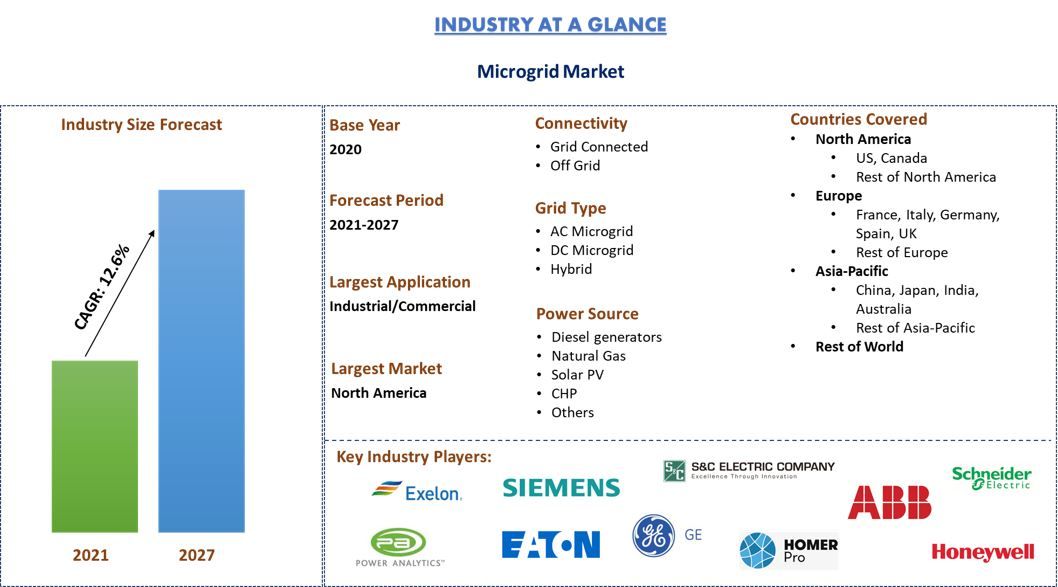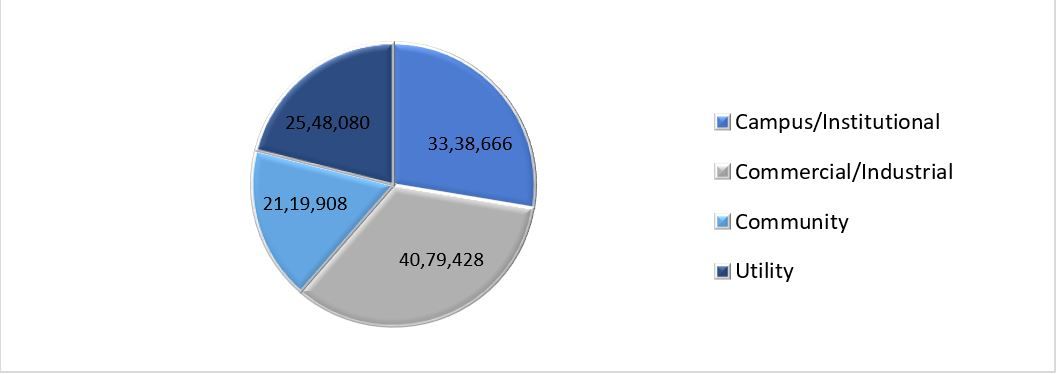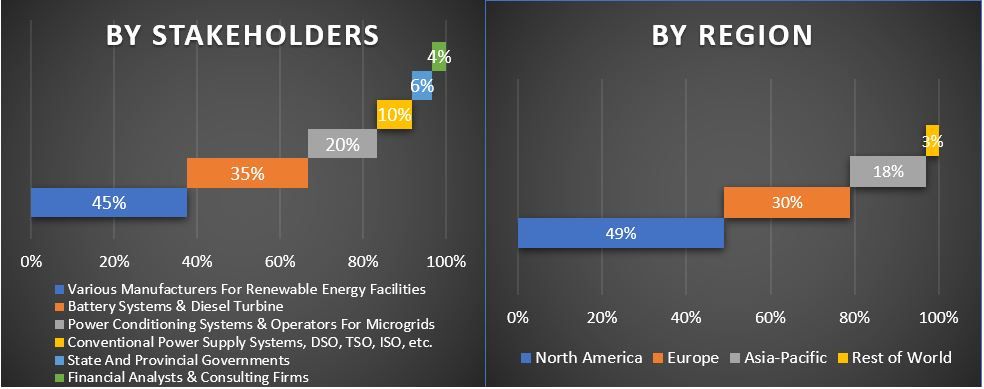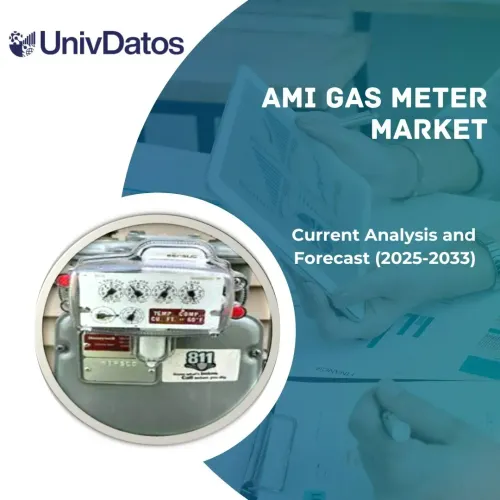- Inicio
- Acerca de nosotros
- Industria
- Servicios
- Leyendo
- Contáctenos
Mercado de microrredes: Análisis actual y pronóstico (2021-2027)
Énfasis en la conectividad (conectado a la red, aislado de la red); Tipo de red (microrred de CA, microrred de CC, híbrida); Fuente de energía (generadores diésel, gas natural, energía solar fotovoltaica, calor y energía combinados (CHP) y otros); Dispositivo de almacenamiento (iones de litio, plomo-ácido, batería de flujo, volantes de inercia, otros); Aplicación (atención médica, instituciones educativas, militar, servicios públicos, industrial/comercial, remoto, otros); Región y país
El mercado mundial de microrredes se valoró en US$ 28,6 mil millones en 2019 y se espera que crezca a una TCAC significativa del 12,6% durante el período de pronóstico (2021-2027). Una microrred es una red de energía tradicional de funcionamiento autónomo, es decir, es como una red de energía local, pero tiene capacidad de control y puede desconectarse de la red para operar de forma autónoma. Según el Grupo de Intercambio de Microrredes del Departamento de Energía de EE. UU., una microrred es un grupo de cargas y fuentes de energía conectadas dentro de límites eléctricos claramente definidos y actúa como una sola entidad controlable con respecto a la red. Una microrred puede conectarse y desconectarse de la red, lo que le permite operar tanto en modo conectado a la red como en modo isla. Con la caída del costo de la energía solar y sus beneficios ambientales, la mayoría de las microrredes hoy en día están diseñadas para suministrar electricidad con una combinación de energía solar y almacenamiento en baterías. Las redes conectan empresas, hogares y otros edificios a una fuente de energía central que permite el funcionamiento de aparatos como dispositivos electrónicos, sistemas de calefacción/refrigeración, etc. Debido a esto, cuando una parte de la red necesita ser reparada, todos se ven afectados. Las microrredes ayudan en este aspecto. Las microrredes pueden separarse de la red principal y funcionar con su propia energía local en tiempos de crisis, como cortes de energía y tormentas.
El principal impulsor del crecimiento de este mercado es su capacidad para producir energía limpia. Las microrredes pueden ser alimentadas por tecnologías renovables como sistemas eólicos, sistemas solares, microturbinas, sistemas híbridos y turbinas de combustión. Las microrredes se pueden integrar con estas tecnologías renovables para reducir las huellas de carbono en el medio ambiente. Varios gobiernos en todo el mundo están tomando iniciativas para reducir las huellas de carbono en el medio ambiente, por ejemplo, el Gobierno de Delhi, India, inició una transición a vehículos de cero emisiones en 2020, con el objetivo de que el 25% de todos los vehículos recién registrados sean vehículos eléctricos para 2024, cuyo número actualmente es del 0,2%. Algunos inconvenientes que puede encontrar el mercado de las microrredes incluyen el costo inicial de instalación y el alto costo de mantenimiento de las microrredes. Los costos de instalación de la microrred son entre un 25 y un 30% más altos que las redes tradicionales.
Costos medios normalizados de microrredes (US$/MW), Estados Unidos, 2018
ABB, General Electric Company, Siemens AG, Eaton Corporation Inc, Schneider Electric SE, Honeywell International Inc., HOMER Energy LLC, S&C Electric Company, Power Analytics Corporation y Exelon Corporation son algunos de los actores destacados que operan en el mercado global de microrredes. Estos actores han emprendido varias fusiones y adquisiciones junto con asociaciones para facilitar a los clientes productos/tecnologías innovadores y de alta tecnología.
Perspectivas presentadas en el informe
“Entre la conectividad, el segmento fuera de la red tiene la mayor participación”
Según la conectividad, el mercado global de microrredes se segmenta en conectado a la red y fuera de la red. Entre la conectividad, el segmento fuera de la red del mercado global de microrredes se valoró en US$ XX mil millones en 2020 y es probable que alcance los US$ XX mil millones para 2027 y está creciendo a una TCAC del XX% de 2021 a 2027. El uso de sistemas de microrred fuera de la red está ganando popularidad a medida que crece su necesidad de cortes de energía en áreas remotas. Existe una demanda creciente de infraestructura eléctrica en las áreas rurales y, debido a esto, es más fácil instalar microrredes fuera de la red para mejorar las infraestructuras ya construidas en estas regiones.
“Entre el tipo de red, el segmento de microrredes de CA tiene la mayor participación”
Según el tipo de red, el mercado global de microrredes se segmenta en microrred de CA, microrred de CC e híbrida. Entre el tipo de red, la microrred de CA representó una valoración de mercado de US$ XX mil millones en 2020 y se espera que alcance los US$ XX mil millones para el año 2027, a una TCAC del XX% durante el período analizado. Las microrredes de CA pueden reducir las pérdidas de transmisión con una generación de calor mínima y tienen niveles de voltaje de alta gama efectivos en toda la red. Es probable que esto influya en la demanda de esta tecnología. Además, también son altamente compatibles con las redes eléctricas y no necesitan inversores para el suministro de energía. Además, se pueden implementar con grandes parques eólicos y solares, lo que puede mejorar aún más su crecimiento en el mercado.
“Entre la fuente de energía, el segmento de gas natural tiene la mayor participación”
Según la fuente de energía, el mercado global de microrredes se segmenta en generadores diésel, gas natural, energía solar fotovoltaica, CHP y otros. El segmento de gas natural generó ingresos de US$ XX mil millones en 2020 y se espera que crezca a una TCAC del XX% durante el período de pronóstico para alcanzar una valoración de mercado de US$ XX mil millones para 2027F. Las políticas gubernamentales están favoreciendo la integración de la generación de energía eficiente y sostenible para impulsar la infraestructura de microrredes alimentada por gas natural (GN). El cambio hacia fuentes de energía renovables y la reducción de su huella de carbono está impulsando el uso de microrredes de gas natural.
“Entre el dispositivo de almacenamiento, el segmento de iones de litio tiene la mayor participación”
Según el dispositivo de almacenamiento, el mercado global de microrredes se segmenta en iones de litio, plomo-ácido, batería de flujo, volantes de inercia y otros. Entre los dispositivos de almacenamiento, el segmento de iones de litio del mercado global de microrredes se valoró en US$ XX mil millones en 2020 y es probable que alcance los US$ XX mil millones para 2027 y está creciendo a una TCAC del XX% de 2021 a 2027. Las baterías son una parte importante del sistema de microrredes, ya que mejoran el rendimiento, la eficiencia del generador y la confiabilidad del sistema. Estos dispositivos de almacenamiento pueden minimizar el consumo de combustible. Hasta hace poco, los dispositivos de almacenamiento de plomo-ácido se consideraban los más económicos y eran los más populares.
“Entre la aplicación, el segmento industrial/comercial tiene la mayor participación”
Según la aplicación, el mercado global de microrredes se segmenta en atención médica, instituciones educativas, militar, servicios públicos, industrial/comercial, remoto y otros. Entre las aplicaciones, el segmento industrial/comercial representó una valoración de mercado de US$ XX mil millones en 2020 y se espera que alcance los US$ XX mil millones para el año 2027, a una TCAC del XX% durante el período analizado. Los crecientes esfuerzos del gobierno para renovar y reconstruir las redes de T&D existentes junto con la instalación de soluciones de eficiencia energética ayudarán a impulsar las perspectivas comerciales. Por ejemplo, la red estatal de Liu Zhenya de China tiene casi 1 millón de empleados y 1.100 millones de clientes y tiene planes de conectar el mundo entero con líneas de transmisión, comenzando con Asia.
“América del Norte representa uno de los mercados más grandes del mercado global de microrredes”
Para una mejor comprensión de la dinámica del mercado del mercado global de microrredes, se llevó a cabo un análisis detallado para diferentes regiones de todo el mundo, incluyendo América del Norte (EE. UU., Canadá y el resto de América del Norte), Europa (Alemania, Francia, Italia, Reino Unido, España y resto de Europa), Asia-Pacífico (China, Japón, India, Australia y resto de APAC) y el resto del mundo. América del Norte dominó el mercado y acaparó alrededor del XX% de la cuota de mercado debido a la creciente adopción de energía renovable en todo el mundo.
Razones para comprar este informe:
- El estudio incluye análisis de tamaño y pronóstico del mercado validados por expertos clave autenticados de la industria
- El informe presenta una revisión rápida del desempeño general de la industria de un vistazo
- El informe cubre un análisis en profundidad de los pares de la industria prominentes con un enfoque principal en las finanzas comerciales clave, la cartera de productos, las estrategias de expansión y los desarrollos recientes
- Examen detallado de los impulsores, las restricciones, las tendencias clave y las oportunidades que prevalecen en la industria
- El estudio cubre exhaustivamente el mercado en diferentes segmentos
- Análisis profundo a nivel regional de la industria
Opciones de personalización:
El mercado de microrredes se puede personalizar aún más según los requisitos o cualquier otro segmento de mercado. Además de esto, UMI entiende que puede tener sus propias necesidades comerciales, por lo tanto, no dude en conectarse con nosotros para obtener un informe que se adapte completamente a sus necesidades.
Tabla de contenido
El análisis del mercado histórico, la estimación del mercado actual y la previsión del mercado futuro del mercado global de microrredes fueron los tres pasos principales que se llevaron a cabo para crear y analizar la adopción de microrredes globales en las principales regiones a nivel mundial. Se llevó a cabo una investigación secundaria exhaustiva para recopilar las cifras del mercado histórico y estimar el tamaño del mercado actual. En segundo lugar, para validar estos conocimientos, se tomaron en consideración numerosos hallazgos y supuestos. Además, también se realizaron extensas entrevistas primarias con expertos de la industria en toda la cadena de valor del mercado global de microrredes. Tras la suposición y la validación de las cifras del mercado a través de entrevistas primarias, empleamos un enfoque de arriba hacia abajo/de abajo hacia arriba para pronosticar el tamaño completo del mercado. Posteriormente, se adoptaron métodos de desglose del mercado y triangulación de datos para estimar y analizar el tamaño del mercado de los segmentos y subsegmentos a los que pertenece la industria. La metodología detallada se explica a continuación:
Buscar más detalles sobre la metodología de investigación
Análisis del tamaño del mercado histórico
Paso 1: Estudio en profundidad de fuentes secundarias:
Se realizó un estudio secundario detallado para obtener el tamaño del mercado histórico de la microrred global a través de fuentes internas de la empresa, como informes anuales y estados financieros, presentaciones de rendimiento, comunicados de prensa, etc. y fuentes externas, incluidos revistas, noticias y artículos, publicaciones gubernamentales, publicaciones de la competencia, informes del sector, bases de datos de terceros y otras publicaciones creíbles.
Paso 2: Segmentación del mercado:
Después de obtener el tamaño del mercado histórico del mercado global de microrredes, llevamos a cabo un análisis secundario detallado para recopilar información histórica del mercado y compartirla para diferentes segmentos y subsegmentos para las principales regiones. Los principales segmentos incluidos en el informe son la conectividad, el tipo de red, la fuente de energía, el dispositivo de almacenamiento y la aplicación. Además, se realizaron análisis regionales y a nivel de país para evaluar la adopción general de microrredes en esa región.
Paso 3: Análisis de factores:
Después de adquirir el tamaño del mercado histórico de diferentes segmentos y subsegmentos, llevamos a cabo un análisis de factores detallado para estimar el tamaño actual del mercado de la microrred global. Además, llevamos a cabo un análisis de factores utilizando variables dependientes e independientes, como el aumento de la temperatura global y los cambios en las políticas gubernamentales. Se llevó a cabo un análisis exhaustivo de los escenarios de oferta y demanda teniendo en cuenta las principales asociaciones, fusiones y adquisiciones, la expansión empresarial y los lanzamientos de productos en el sector de las microrredes en todo el mundo.
Estimación y previsión del tamaño del mercado actual
Tamaño del mercado actual: Basándonos en la información práctica de los 3 pasos anteriores, llegamos al tamaño actual del mercado, los actores clave en el mercado global de microrredes y las cuotas de mercado de los segmentos. Todos los porcentajes de cuota requeridos y los desgloses del mercado se determinaron utilizando el enfoque secundario mencionado anteriormente y se verificaron a través de entrevistas primarias.
Estimación y previsión: Para la estimación y previsión del mercado, se asignaron ponderaciones a diferentes factores, incluidos los impulsores y las tendencias, las restricciones y las oportunidades disponibles para las partes interesadas. Después de analizar estos factores, se aplicaron técnicas de previsión relevantes, es decir, un enfoque de arriba hacia abajo/de abajo hacia arriba para llegar a la previsión del mercado alrededor de 2027 para diferentes segmentos y subsegmentos en los principales mercados a nivel mundial. La metodología de investigación adoptada para estimar el tamaño del mercado abarca:
- El tamaño del mercado de la industria, en términos de valor (US$) y la tasa de adopción de la microrred global en los principales mercados a nivel nacional
- Todos los porcentajes de cuota, divisiones y desgloses de los segmentos y subsegmentos del mercado
- Actores clave en el mercado global de microrredes en términos de productos ofrecidos. Además, las estrategias de crecimiento adoptadas por estos actores para competir en el mercado de rápido crecimiento
Validación del tamaño y la cuota de mercado
Investigación primaria: Se realizaron entrevistas en profundidad con los líderes de opinión clave (KOL), incluidos los ejecutivos de alto nivel (CXO/VP, jefe de ventas, jefe de marketing, jefe de operaciones y jefe regional, jefe de país, etc.) en las principales regiones. Los hallazgos de la investigación primaria se resumieron y se realizó un análisis estadístico para demostrar la hipótesis establecida. Los datos de la investigación primaria se consolidaron con los hallazgos secundarios, convirtiendo así la información en información práctica.
División de los participantes primarios en diferentes regiones
Ingeniería de mercado
Se empleó la técnica de triangulación de datos para completar la estimación general del mercado y llegar a cifras estadísticas precisas de cada segmento y subsegmento del mercado global de microrredes. Los datos se dividieron en varios segmentos y subsegmentos después de estudiar varios parámetros y tendencias en las áreas de tipo y su tipo de mercado global de microrredes.
El objetivo principal del estudio del mercado global de microrredes
Las tendencias actuales y futuras del mercado de la microrred global se señalaron en el estudio. Los inversores pueden obtener información estratégica para basar su discreción para las inversiones a partir del análisis cualitativo y cuantitativo realizado en el estudio. Las tendencias actuales y futuras del mercado determinaron el atractivo general del mercado a nivel regional, proporcionando una plataforma para que el participante industrial explote el mercado sin explotar para beneficiarse como una ventaja de ser el primero en actuar. Otros objetivos cuantitativos de los estudios incluyen:
- Analizar el tamaño actual y previsto del mercado de la microrred global en términos de valor (US$). Además, analice el tamaño actual y previsto del mercado de diferentes segmentos y subsegmentos
- Los segmentos del estudio incluyen áreas de tipo y sus subtipos
- Definir y analizar el marco regulatorio para la industria global de microrredes
- Analizar la cadena de valor involucrada con la presencia de varios intermediarios, junto con el análisis de los comportamientos de los clientes y la competencia de la industria
- Analizar el tamaño actual y previsto del mercado del mercado global de microrredes para las principales regiones
- Las principales regiones estudiadas en el informe incluyen América del Norte (EE. UU., Canadá y el resto de América del Norte), Europa (Alemania, Reino Unido, Francia, España, Italia y el resto de Europa), Asia-Pacífico (China, Japón, India, Australia y otros) y el resto del mundo
- Perfiles de las empresas del mercado global de microrredes y las estrategias de crecimiento adoptadas por los participantes del mercado para mantenerse en el mercado de rápido crecimiento
- Análisis regional profundo de la industria
Relacionados Informes
Los clientes que compraron este artículo también compraron













